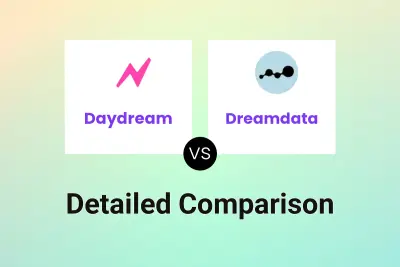 Daydream
VS
Daydream
VS
 Dreamdata
Dreamdata
Daydream
Daydream is a comprehensive revenue command center that transforms how B2B companies handle their revenue operations. By connecting multiple data sources including CRM, call transcripts, product usage, and marketing touches, it provides AI-powered insights and automated reporting capabilities that elevate business intelligence to new heights.
The platform stands out by offering a collaborative workspace where teams can generate deep GTM insights instantly, replacing fragmented reporting systems with a unified solution. With over 500 data integrations and expert support, Daydream enables companies to implement best practices quickly while providing investor-ready metrics, pipeline visibility, and full-funnel marketing analytics.
Dreamdata
Dreamdata provides a comprehensive B2B go-to-market data platform designed to connect marketing activities directly to revenue outcomes. It automatically gathers and structures data across various touchpoints, offering businesses a unified view of their customer journeys. This allows for a clearer understanding of how different channels, campaigns, and content contribute to pipeline generation and overall revenue.
The platform enables detailed performance analysis through data-driven attribution models, helping marketing teams identify the true return on investment (ROI) for their initiatives. By tracking interactions and utilizing intent signals from multiple sources, including first-party tracking and integrations like LinkedIn ads and G2, Dreamdata helps prioritize sales and account-based marketing efforts towards high-potential accounts. It also facilitates the creation and activation of custom audiences by syncing data back to advertising platforms.
Pricing
Daydream Pricing
Daydream offers Free Trial pricing .
Dreamdata Pricing
Dreamdata offers Freemium pricing with plans starting from $999 per month .
Features
Daydream
- AI-Powered Analytics: Automatic scanning of CRM data, calls, and marketing for insights
- Automated Reporting: One-click report generation across all connected tools
- Data Integration: 500+ integrations with various business tools
- Collaborative Workspace: Shared environment for cross-functional team alignment
- Pipeline Management: Comprehensive deal visibility and tracking
- Self-Serve Insights: No-SQL required data exploration capabilities
- Revenue Metrics: Automatic generation of SaaS metrics and KPIs
- Full-Funnel Visibility: End-to-end tracking from marketing spend to closed deals
Dreamdata
- Customer Journey Mapping: Provides interactive timelines showing every touchpoint for each account.
- Performance Attribution: Utilizes data-driven attribution models to measure the revenue impact of channels, campaigns, and content.
- Revenue Analytics: Delivers detailed reporting on revenue, ROI, ROAS, and CAC.
- Intent Data Revelation (Reveal): Identifies buying signals from first-party tracking, LinkedIn ads, G2, and other sources.
- Audience Hub: Allows creation of custom audiences from go-to-market data and syncs them with ad platforms like LinkedIn and Google Ads.
- Data Platform: Offers robust data collection, modeling, tracking, and numerous integrations (CRM, ad platforms, marketing automation).
- B2B Benchmarking: Compares company performance against industry benchmarks based on size and ad budget.
- Unified Ad Spend Reporting: Consolidates ad spend data across multiple platforms.
Use Cases
Daydream Use Cases
- Executive reporting and metrics tracking
- Sales pipeline management and forecasting
- Marketing funnel optimization
- Customer success and expansion monitoring
- Board meeting preparation
- Team performance tracking
- Revenue operations management
- Strategic decision making
Dreamdata Use Cases
- Measuring the ROI of marketing campaigns.
- Understanding the complete B2B customer journey.
- Attributing revenue to specific marketing channels and content.
- Optimizing ad spend based on performance data.
- Identifying and prioritizing high-intent accounts for sales outreach.
- Creating targeted audiences for ad campaigns.
- Improving alignment between marketing and sales teams.
- Reporting marketing's impact on pipeline and revenue to stakeholders.
Uptime Monitor
Uptime Monitor
Average Uptime
99.82%
Average Response Time
160.83 ms
Last 30 Days
Uptime Monitor
Average Uptime
100%
Average Response Time
164.67 ms
Last 30 Days
Daydream
Dreamdata
More Comparisons:
Didn't find tool you were looking for?
